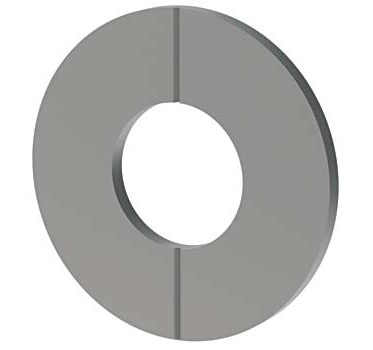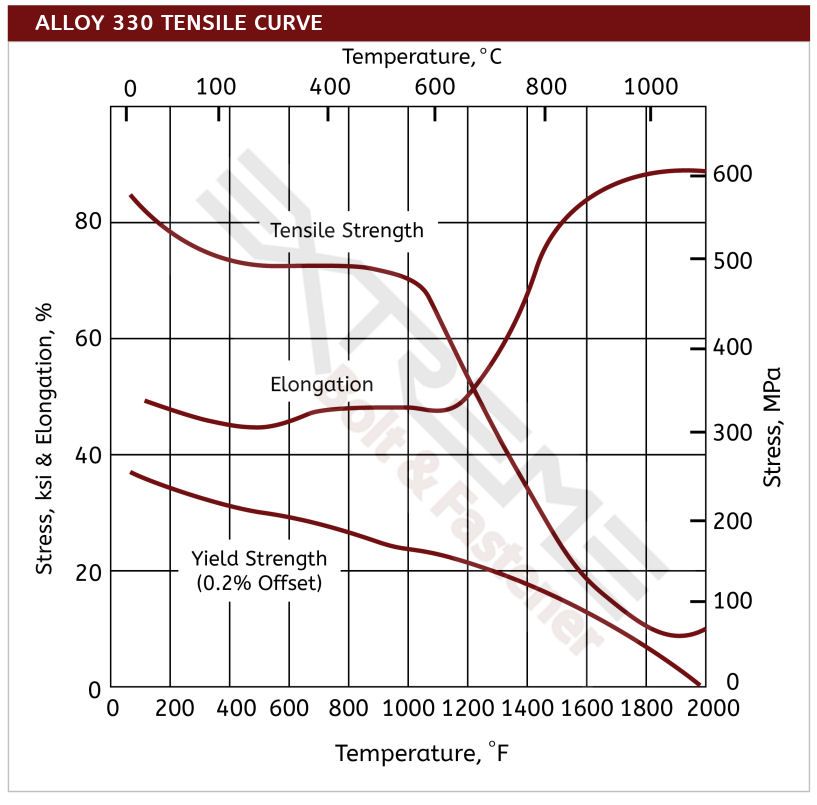An engineered high temperature resistant steel
- Excellent high temperature stability and strength
- Very oxidation and carburization resistant to 2100°F
- Good resistance to thermal shock and quenching
- Chemistry and specifications of Alloy 330
- Alloy 330 vented screw features and benefits
- Strength and mechanical properties
- Datasheet for Alloy 330
Alloy 330 vented screws are specifically designed for high temperature furnace applications such as vacuum furnaces, heat treating and brazing applications. The most prized trait of alloy 330 is its ability perform under cyclic conditions of temperature extremes from heating and cooling; as well as in alternate carburizing and oxidizing atmospheres. An austenitic nickel-chromium-iron-silicon alloy, 330 vented screws also offer industry a low coefficient of expansion, excellent ductility, and high strength.
Benefits & Corrosion Resistance
- Resistance to thermal shock from repeated quenching
- High level of resistance to oxidation and carburization
- Ability to handle thermal cycling
- Provides resistance to scale formation up to about 2000°F
- Good resistance to nitrogen-containing atmospheres where the oxygen content is low
- High nickel content of 34-37% provides high resistance to chloride stress corrosion cracking and embrittlement
Applications for Alloy 330 Vented Screws
- Alloy 330 vented screws are often used in furnaces, thermal processing and heat treating applications.
- Gas turbine components and boiler fixtures used in power generation often use Alloy 330 vented screws.
- Because of its resistance to nitrogen rich environments, alloy 330 vented screws are used extensively for components handling cracked ammonia.
Resources: Alloy 330 Torque Specs
Alloy 330 Screw Types: 12 Point Screws, Button Head Cap Screws, Flat Head Screws, Hex Head Cap Screws, Pan Head Screws, Set Screws, Socket Head Cap Screws, Tamper Resistant Security Screws, Torx Screws, Vented Screws
Alloy 330 Vented Screw Features & Benefits
Alloy 330 vented screws are ideal for use in high vacuum (UV) and ultra high vacuum (UHV) equipment, as well as other high pressure environments and applications where gas pockets can form. Center vented screws have a center bore drilled through their axis from the head through the threaded shank of the screw. This feature provides an outlet for the complete evacuation of trapped air and gas contaminants to be pumped away from blind-tapped screw holes, bottoms, sides and shoulders. In addition to vented screws, washers with vent grooves can be made to ensure the venting of the cavity found under the screw head.
Alloy 330 Vented Screws Benefits
• Enables faster, more efficient pump-down of HV & UHV systems
• Eliminates virtual leaks
• Relieves pressure from blocked gases
• Provides means to vent contaminants found in screw voids
• Promotes higher system throughput and improved yield
• Allows for constant pressure and temperature equalization
Alloy 330 Vented Screws Are Available In:
• Socket Head Cap Screw
• Hex Head Cap Screw

What is a vented washer?
When a screw is tightened over a flat washer, or directly an application without a washer, volumes of gas can be trapped in the space and beneath the fastener head along the screw shaft. Vented washers feature two bored canals on opposite sides of the flat face which provide an escape route for trapped gases.
What is a virtual leak?
A virtual leak is comprised of gases that are trapped physically within a pocket with only a miniscule escape path from the trapped pocket of gas into the chamber proper.
Alloy 330 Chemistry and Specifications
Alloy 330 (UNS N08330) is best known for its extreme high temperature strength and stability. One of the most unique attributes of Alloy 330 is its ability to handle cyclic temperature changes from extreme high temperatures to cooling phases, as well as in oxidation-rich environements.
Alloy 330 Specifications: UNS N08330, AMS 5592, AMS 5716, ASME SB 511, ASME SB 536, ASTM B 511, ASTM B 512, ASTM B 535, ASTM B 536, ASTM B 546, ASTM B 710, ASTM B 739, EN 10095, Werkstoff 1.4886



